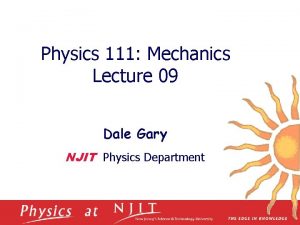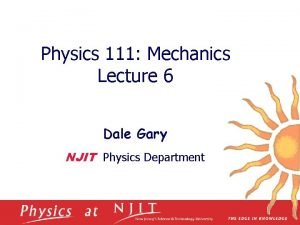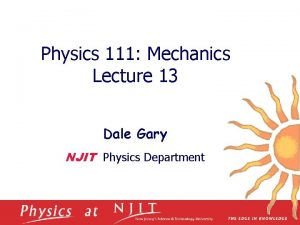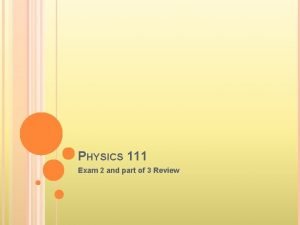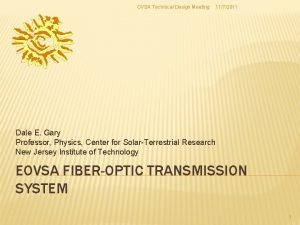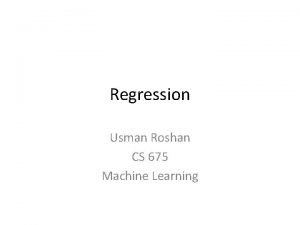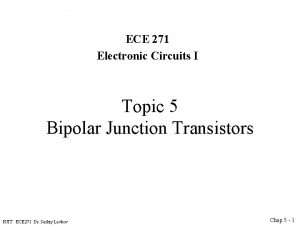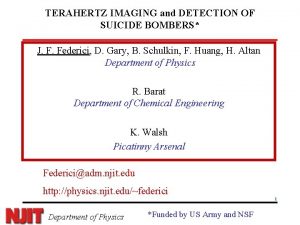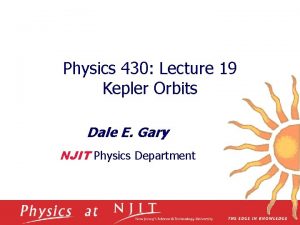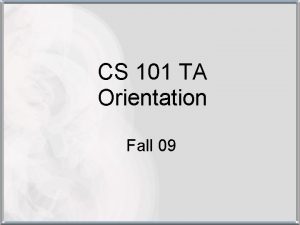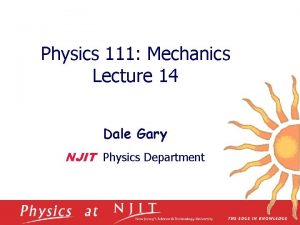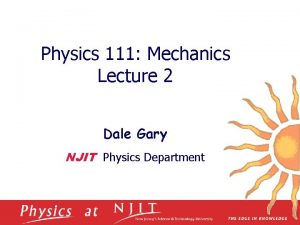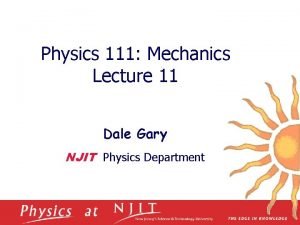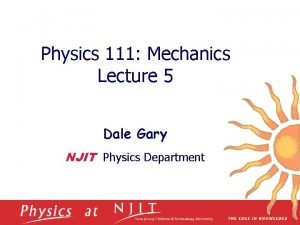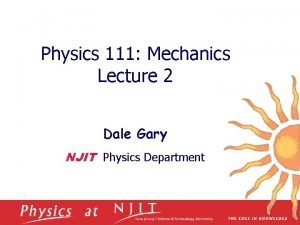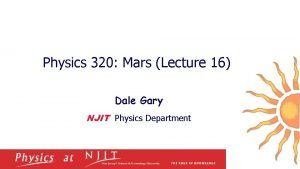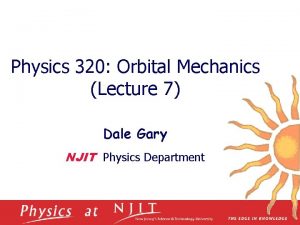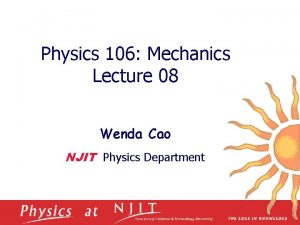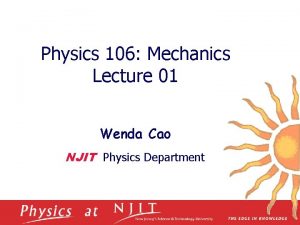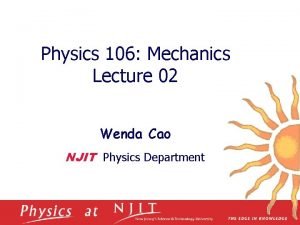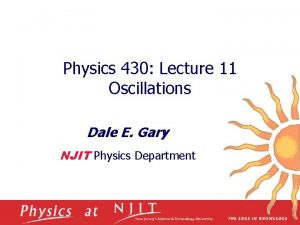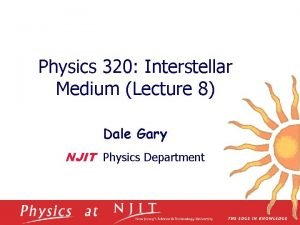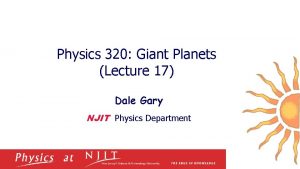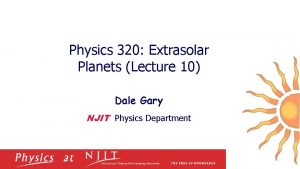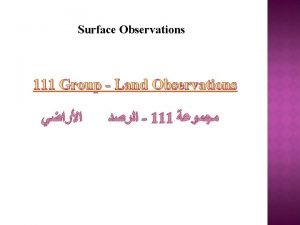Physics 111 Mechanics Lecture 3 Dale Gary NJIT

























- Slides: 25

Physics 111: Mechanics Lecture 3 Dale Gary NJIT Physics Department

Motion in Two Dimensions q q q q Reminder of vectors and vector algebra Displacement and position in 2 -D Average and instantaneous velocity in 2 -D Average and instantaneous acceleration in 2 -D Projectile motion Uniform circular motion Relative velocity* February 5 -8, 2013

Vector and its components q The components are the legs of the right triangle whose hypotenuse is A Or, February 5 -8, 2013

Vector Algebra q Which diagram can represent A) B) C) D) ? February 5 -8, 2013

Motion in two dimensions q q Kinematic variables n Position: n Velocity: n Acceleration: in one dimension x(t) m v(t) m/s a(t) m/s 2 x Kinematic variables in three dimensions n Position: m n Velocity: m/s n Acceleration: m/s 2 y j i x q All are vectors: have direction and magnitudes k z February 5 -8, 2013

Position and Displacement q In one dimension x 1 (t 1) = - 3. 0 m, x 2 (t 2) = + 1. 0 m Δx = +1. 0 m + 3. 0 m = +4. 0 m q In two dimensions n Position: the position of an object is described by its position vector --always points to particle from origin. n Displacement: February 5 -8, 2013

Average & Instantaneous Velocity q Average velocity q Instantaneous velocity q v is tangent to the path in x-y graph; February 5 -8, 2013

Motion of a Turtle A turtle starts at the origin and moves with the speed of v 0=10 cm/s in the direction of 25° to the horizontal. (a) Find the coordinates of a turtle 10 seconds later. (b) How far did the turtle walk in 10 seconds? February 5 -8, 2013

Motion of a Turtle Notice, you can solve the equations independently for the horizontal (x) and vertical (y) components of motion and then combine them! q X components: q Y components: q Distance from the origin: February 5 -8, 2013

Average & Instantaneous Acceleration q Average acceleration q Instantaneous acceleration The magnitude of the velocity (the speed) can change q The direction of the velocity can change, even though the magnitude is constant q Both the magnitude and the direction can change q February 5 -8, 2013

Summary in two dimension q Position q Average velocity q Instantaneous velocity q Acceleration q are not necessarily same direction. February 5 -8, 2013

Motion in two dimensions q q Motions in each dimension are independent components Constant acceleration equations q Constant acceleration equations hold in each dimension n t = 0 beginning of the process; where ax and ay are constant; Initial velocity initial displacement February 5 -8, 2013 ;

Hints for solving problems q q q Define coordinate system. Make sketch showing axes, origin. List known quantities. Find v 0 x , v 0 y , ax , ay , etc. Show initial conditions on sketch. List equations of motion to see which ones to use. Time t is the same for x and y directions. x 0 = x(t = 0), y 0 = y(t = 0), v 0 x = vx(t = 0), v 0 y = vy(t = 0). Have an axis point along the direction of a if it is constant. February 5 -8, 2013

Projectile Motion q q q 2 -D problem and define a coordinate system: x- horizontal, y- vertical (up +) Try to pick x 0 = 0, y 0 = 0 at t = 0 Horizontal motion + Vertical motion Horizontal: ax = 0 , constant velocity motion Vertical: ay = -g = -9. 8 m/s 2, v 0 y = 0 Equations: Horizontal Vertical February 5 -8, 2013

Projectile Motion q X and Y motions happen independently, so we can treat them separately Horizontal q q q Vertical Try to pick x 0 = 0, y 0 = 0 at t = 0 Horizontal motion + Vertical motion Horizontal: ax = 0 , constant velocity motion Vertical: ay = -g = -9. 8 m/s 2 x and y are connected by time t y(x) is a parabola February 5 -8, 2013

Projectile Motion 2 -D problem and define a coordinate system. q Horizontal: ax = 0 and vertical: ay = -g. q Try to pick x 0 = 0, y 0 = 0 at t = 0. q Velocity initial conditions: q n n n q v 0 can have x, y components. v 0 x is constant usually. v 0 y changes continuously. Equations: Horizontal Vertical February 5 -8, 2013

Trajectory of Projectile Motion Initial conditions (t = 0): x 0 = 0, y 0 = 0 v 0 x = v 0 cosθ 0 and v 0 y = v 0 sinθ 0 q Horizontal motion: q q Vertical motion: q Parabola; n θ 0 = 0 and θ 0 = 90 ? February 5 -8, 2013

What is R and h ? q Initial conditions (t = 0): x 0 = 0, y 0 = 0 v 0 x = v 0 cosθ 0 and v 0 x = v 0 sinθ 0, then h Horizontal Vertical February 5 -8, 2013

Projectile Motion at Various Initial Angles q Complementary values of the initial angle result in the same range n The heights will be different q The maximum range occurs at a projection angle of 45 o February 5 -8, 2013

Uniform circular motion Constant speed, or, constant magnitude of velocity Motion along a circle: Changing direction of velocity February 5 -8, 2013

Circular Motion: Observations q Object moving along a curved path with constant speed n n n Magnitude of velocity: same Direction of velocity: changing Velocity: changing Acceleration is NOT zero! Net force acting on the object is NOT zero “Centripetal force” February 5 -8, 2013

Uniform Circular Motion q Centripetal acceleration vi A vf vi Δv = vf - vi y Δr ri B vf R rf O q Direction: Centripetal February 5 -8, 2013 x

Uniform Circular Motion q Velocity: n Magnitude: constant v n The direction of the velocity is tangent to the circle q Acceleration: n Magnitude: n directed toward the center of the circle of motion q Period: n time interval required for one complete revolution of the particle February 5 -8, 2013

Summary q Position q Average velocity q Instantaneous velocity q Acceleration q are not necessarily in the same direction. February 5 -8, 2013

Summary q If a particle moves with constant acceleration a, motion equations are q Projectile motion is one type of 2 -D motion under constant acceleration, where ax = 0, ay = -g. February 5 -8, 2013
 Njit physics 111
Njit physics 111 Classical mechanics
Classical mechanics Dale gary
Dale gary 000 111 000
000 111 000 Njit physics
Njit physics Kepler 4 njit
Kepler 4 njit Physics 111 exam 1
Physics 111 exam 1 01:640:244 lecture notes - lecture 15: plat, idah, farad
01:640:244 lecture notes - lecture 15: plat, idah, farad Njit machine learning
Njit machine learning Cs 288 njit
Cs 288 njit 1172011
1172011 Cristian borcea njit
Cristian borcea njit Ivon nunez njit
Ivon nunez njit Food near njit
Food near njit Njit eop office
Njit eop office Cs 675 njit
Cs 675 njit Reverse transfer njit
Reverse transfer njit What is eop
What is eop Njit suicide
Njit suicide Kepler 4 njit
Kepler 4 njit Njit gds
Njit gds Cs 288 njit
Cs 288 njit Cs 288 njit
Cs 288 njit Cs101 njit
Cs101 njit Physics 101 lecture notes pdf
Physics 101 lecture notes pdf Phy101 lecture 1
Phy101 lecture 1
